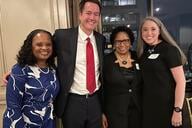You have /5 articles left.
Sign up for a free account or log in.
The recent holiday break allowed me to catch up on global news and read a number of articles I had added to my Pocket app. No matter your political leaning, there’s no way to avoid reading about or being drawn into a conversation on the presidential race in the United States. And something one of the candidates said recently reflected the high-pressure faced by so many cabinet-level positions in higher education.
Last week, Ben Carson experienced a significant transition on his campaign’s leadership team. When asked by the media about the departures of the campaign manager and communications director, he said “failures by his top campaign staff to execute an effective strategy forced him to undertake a major personnel shake-up last week.” This language was much different than the accounts from the two campaign leaders who announced their resignations just days prior.
The comment stopped me dead in my tracks, and I felt compelled to re-read that quote a number of times. There is something vitally important about how that was phrased that directly relates to higher education and the position my peers often are desperate to escape.
My experiences have taught me to ask a very important question when I read a statement about a communication officer’s inability to implement strategy: Was there a strategy and direction for them to implement and communicate in the first place?
The role of a communications officer is to communicate. Nothing surprising, right? Having said that, I am forever amazed at the expectations for communications officers to instead serve as miracle workers and magicians. Many of us are damn good at what we do, but I can assure you that skillset comes from hard work rather than magic wands.
We want to be part of the conversations and deliberations on strategic planning and help to shape the direction of the institution and its future initiatives, but we understand that the president holds the key decision-making authority. Once a leadership direction is provided, we should be allowed to use our creativity and expertise to draft communications strategies, or in other words, think through the ways to best communicate what are often complex messages. We set expectations for engagement and hopefully are allowed to deliver on those promises.
All of this is predicated on one important element—we need decisions to be made and for direction to be given before we can begin our work. Our job isn’t to create the institution’s strategy—it is to inform key audiences of the decisions made, their impact and what comes next. If no decisions are being made or there is hemming and hawing on the future direction of an institution, then we have very little to communicate and our efforts risk eroding trust and limit future efforts. Basically, we are being asked to sell a whole bunch of nothing—and our audiences are quite talented at identifying garbage messages no matter how hard we work or what words we use.
And those words alone cannot remedy a situation or build trust—in an ideal situation, leadership is provided, corresponding actions are taken and then communications occur, so that forward momentum can be built and promises kept.
Communications officers are happy to begin our work once a leadership position has been claimed. Then, we know what we are building toward, who we are including in our efforts, who is impacted and the direction we need to move. But to hold us accountable for not implementing strategy or an unwillingness to spin a tale is unfair if the strategy and leadership necessary are absent. Sometimes what we need most is leadership—just like the constituents on our campuses.




